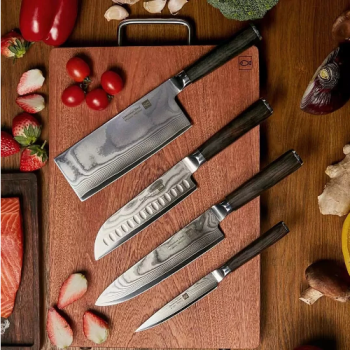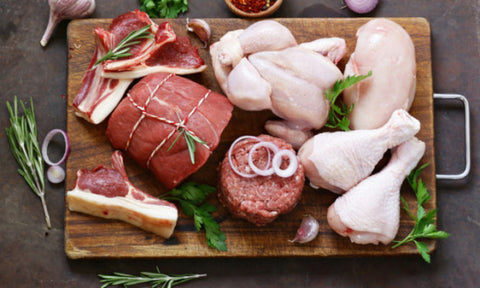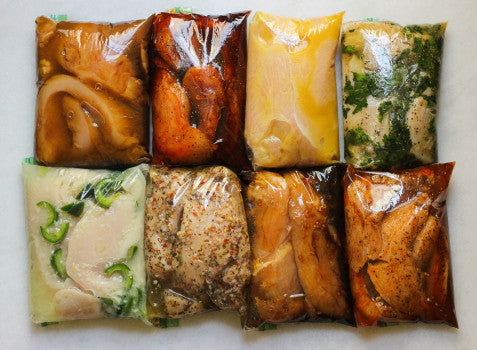One of the basic and most important tools a home should have is a set of sharp kitchen knives. If you've seen a chef at work, you've noticed the different types of knives he uses. Starting from small knives to the biggest ones, where each of them seems to have its own function. But how many of these knives are really necessary in a home kitchen? Today we will talk about six types of knives that you should have in your kitchen and how to best maintain them.
1) Chef's knife
If you strictly had to have only one knife in your kitchen, then the chef's knife would easily take that place. This knife is so useful that it is often cited as the most important tool in the kitchen. Although it falls short in some tasks, it is a powerful multi-tool. It is very capable and can easily slice and handle all basic cuts with ease.
The length of the blade ranges from 20 to 35 cm, it is curved and has a triangular tip. This curve is referred to as the "belly" and is designed to cut according to the movement. Specifically, with the movement determined by the curve of the edge, so that it rests entirely on the cutting surface from the tip to the handle. How to choose the right chef's knife According to experts, one of the key starting points is to choose what you already know and feel comfortable with. The chef's knife can be found in many sizes. The sizes start from 20 cm which is considered small to an imposing and long knife of 35 cm. Many would say it looks more like a small sword than something used for cooking.
What to choose European or Japanese? While European-style knives are designed for a wide range of tasks, Japanese knives have historically been made for more specific tasks. Various tasks such as cutting noodles, slicing fish or slicing vegetables significantly influence the way a knife is designed. In contrast, European-style knives have a more "robust geometry", they are better suited to the rocking motion style to slice or dice materials. your. In general to easily and quickly chop anything you want.
The big difference between the two is that they are made differently, so the cutting technique is also different. Japanese knives have a much sharper angle at the tip, which also makes them suitable for tasks such as cutting or slicing. The movement of the blade goes up and down unlike the European rocking. Still Japanese are more difficult to sharpen and care for.
2) Budgie
The paring knife, otherwise known as a paring knife, has a characteristic curved nose, hence the name. Usually used for small fruits and vegetables. It has a thin, short blade a few centimeters long (about 7 cm). It is not recommended for cutting larger foods, but is ideal for smaller vegetables such as garlic and onions. It is also great for peeling fruit, shrimp and meat. Although a peeler can do the same job, the curved blade of the peeler peels fruits and vegetables much more easily.
3) Bread knife
It is long, with a serrated blade, and its exact dimensions vary according to the use for which we want it. Specifically, this knife is used either to cut bread, or for fruits and vegetables with a fragile surface, such as tomatoes. The blade has a size of 20 to 35 cm. The bread knife is also suitable for cutting cakes, as its long blade can cut through the entire cake in a single pass. It can also cut larger fruits such as melons, watermelons and other large vegetables without crushing or damaging them. Be very careful with the serrated blade because it is easy to cut yourself.
4) Boning knife
For meat lovers, the boning knife is an absolute must. It has a sharp edge and a narrow blade. The blade of the knife is thin, curved and flexible. It is very sharp and made of high quality steel. It is an ideal kitchen tool not only for professional chefs, but also for amateur cooks. The blade of the knife is specially designed and balanced to offer you cutting precision and maximum exploitation of the entire length of the blade. It can be easily cut and the flesh removed from the bones with little loss of meat. Its thin edge allows the cartilage to be easily detached from the joints. Boning knife is preferred for poultry and fish.
5) Universal santoku knife
The santoku knife is very similar to a chef's knife and is a general purpose knife. It is used in both professional and domestic kitchens. You can find the blade either with a ceramic coating or steel. Most professional chefs prefer blades made of steel for their high corrosion resistance. Japanese blades like the Santoku are made from a thin but harder steel that allows chefs to perform precision work. The difference between a Santoku and a chef's knife is mainly about the origin and shape of the blade.
6) Fillet knife
The fillet knife has a thin, flexible blade with a length of around 20 cm. It is an essential tool for filleting fish or meat as well as for removing fat from meat. To see if our blade is good it should remove the maximum amount of meat from bones and cartilage. Specifically for the fish, using a thin knife to clean it will reduce the fat quite a bit, that is, the amount of meat that we can no longer use. One tip is, because the knife rests on bones during boning, it will need good and frequent sharpening.





Comments (0)
There are no comments for this article. Be the first one to leave a message!